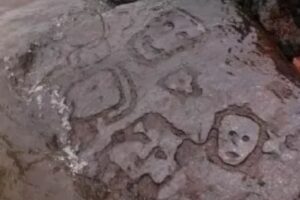Eerie ancient carvings emerge from river…and it's only the second time the mysterious drawings have EVER been seen | The Sun

MYSTERIOUS ancient carvings have emerged from a river for only the second time ever following a drought in the Amazon jungle.
The eerie artworks sculpted onto the rocks are thought to be between 1,000 and 2,000 years old.
The interesting carvings are located where the Rio Negro and Amazon River meet just outside Manaus, Brazil.
Normally these detailed etchings are completely hidden under the water.
But they have been exposed by a drought that has dramatically lowered rivers after the worst dry spell in over a century.
The river at jungle city Manaus is the lowest it’s been in 121 years.
READ MORE IN ANCIENT FINDS

Lost tomb found after 3,400 years with 'Book of the Dead’ & mummified priests

Mysterious message from ancient scroll burned by Vesuvius finally revealed using AI
Now the mysterious etchings are being studied by archaeologists before the water swallows them once more.
They have been dubbed "Caretas" which roughly translates to “little faces”.
Several appear to show people, although the origins are unclear.
A group of five faces sit on one portion of the rock.
Most read in The Sun

Killer storm claims third victim amid warning ‘worst is yet to come’

I thought date couldn’t stoop any lower after raping me but he hid sinister secret

He lit a spliff & passed away, says Paul O’Grady’s husband at memorial

BBC axes football show less than a month after Alex Scott & Dan Walker’s row
Some of the faces are slightly square and none have more than a head, mouth and sometimes a nose.
There are also animals and representations of water on the rocks along with the life-like human heads.
Experts believe more engravings lie beneath the river’s surface, and could be exposed in the coming days as the drought continues.
Archaeologist Jaime Oliveira said: “The archaeological sites we have observed here represent evidence of occupation that provides important insights into the societies that lived in this place.
“These groups also went through periods of drought more severe than what we are experiencing now.
“How can we tell? Just by looking at where we are, at the normal water level, this place is submerged.
“We can conclude that to create these engravings, the river was dry or may not have even existed.”
Oliveira described the work as “complex graphic art” and he believes it to have been made with axes made from chipped stone.
Speaking of the caretas at the site, he added: “These human figures convey emotions, both happiness and sadness.
“As we can see, some are smiling, and others appear despondent.
“We can even say that the engravings represent a state of mind and also reflect a bit of what they experienced during that period.”
The engravings have only been seen once, in 2010, when they were on show for just one day before the river rose again.
Experts believe the art at the Lajes archaeological site could go as far back as 2,000 years.
Although the site is protected by the state, archaeologists haven’t been allowed near the work to study the engravings close up.
Officials from the Geological Survey of Brazil say the Rio Negro may only start rising again in November.
Earlier this year another ancient discovery was found as an underground city in Iran where dozens of skeletons were discovered is about to reopen.
The creepy city of Samen has an astounding 25 rooms connected by tunnels and served as a home back in the Parthian period, around 250 BC to 224 CE.
Read More on The Sun

Rain doesn't stop me from drying my clothes outside – my method's tried & tested

Quality Street fans mourn 'part of Christmas gone' after Nestle makes change
A lost ancient tomb containing the "Book of the Dead" and 3,400-year-old mummified bodies was also uncovered recently.
The burial site was discovered in the Tuna El-Gebel necropolis in southern Egypt and contained mummies, amulets, stone, figurines and jewellery.
Source: Read Full Article





